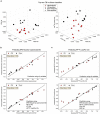This is a preprint.
Hyperpolarized 13C metabolic imaging detects long-lasting metabolic alterations following mild repetitive traumatic brain injury
- PMID: 37645937
- PMCID: PMC10462249
- DOI: 10.21203/rs.3.rs-3166656/v1
Hyperpolarized 13C metabolic imaging detects long-lasting metabolic alterations following mild repetitive traumatic brain injury
Abstract
Career athletes, active military, and head trauma victims are at increased risk for mild repetitive traumatic brain injury (rTBI), a condition that contributes to the development of epilepsy and neurodegenerative diseases. Standard clinical imaging fails to identify rTBI-induced lesions, and novel non-invasive methods are needed. Here, we evaluated if hyperpolarized 13C magnetic resonance spectroscopic imaging (HP 13C MRSI) could detect long-lasting changes in brain metabolism 3.5 months post-injury in a rTBI mouse model. Our results show that this metabolic imaging approach can detect changes in cortical metabolism at that timepoint, whereas multimodal MR imaging did not detect any structural or contrast alterations. Using Machine Learning, we further show that HP 13C MRSI parameters can help classify rTBI vs. Sham and predict long-term rTBI-induced behavioral outcomes. Altogether, our study demonstrates the potential of metabolic imaging to improve detection, classification and outcome prediction of previously undetected rTBI.
Conflict of interest statement
Competing interests The authors declare that they have no competing interests.
Figures





References
-
- Ding K, Gupta PK, Diaz-Arrastia R. Epilepsy after Traumatic Brain Injury. In: Translational Research in Traumatic Brain Injury (eds Laskowitz D, Grant G) (2016). - PubMed
Publication types
Grants and funding
LinkOut - more resources
Full Text Sources
Research Materials
Miscellaneous

